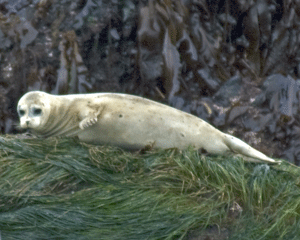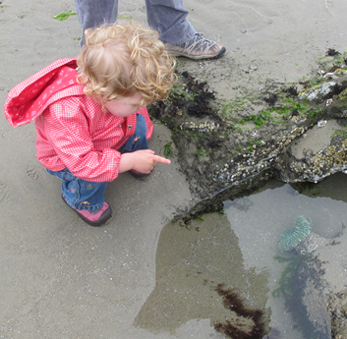Being good visitors
Tidepool organisms are well adapted to meet great challenges at the sea’s edge—but they can also be very sensitive to the kinds of impact people have. Communities that may appear everlasting may take many years to recover from a single damaging event.
This remarkable and valuable resource is well worth protecting—and can be safeguarded by keeping a few points in mind:
Watch your step
Step on bare rock or sand whenever possible—for your safety as well as the safety of the rocky shore inhabitants. Many of Oregon's popular tidepools have plenty of viewing opportunities at the sand-rock interface (where standing on rock can be avoided almost entirely). Unless a walking stick is truly required for your safe travel, please leave it behind: the small tip applies a huge amount of killing force to life on the rocks.
Observe, rather than capture
Slow down, look closely, and watch patiently to observe the sea life in its home. Quietly watching a pool or gently moving seaweed aside will reveal individuals and behavior that would go unnoticed in a rush.
Touch gently
Touch the animals very gently with only one wet finger to lower the chance of harm. Please do not poke or prod.
“If you pry, it will die”
Clamping or attaching to the rock is how many tidepool inhabitants survive heavy wave action: prying them off the rocks will damage them as well as leave them vulnerable to the incoming surf.
“Keep it low and let it go”
Scuttling crabs might tickle, and they may pinch and will try to walk off your hand. If you must pick them up, keep your hands low to the ground so they don’t have far to fall in an accident. Return any picked up inhabitant as soon as possible to its home.
Replace all material you move
The rocks, shells, and seaweeds give protection to the animals below—including the ones you didn’t see: it is important to return moved items to exactly the way you found them.
Don’t take it home—alive or dead!
It is nearly impossible to find a shell with no other living thing in it or on it. “Empty” shells are critical habitat for many other organisms, from hermit crabs to limpets to seaweeds, and more. (In fact, even the minerals in the bits dissolve and enter the water, where they’re taken up later and used to build new shells.)
Share…
your discoveries and delights with others, while modeling and encouraging good tidepool etiquette. Share your favorite photos here and explore those taken by other visitors!
Respect specially designated areas
A few Oregon Coast tidepools are closed to collecting to protect special sites. Tidepool creatures are protected by Oregon Department of Fish and Wildlife (ODFW) regulations. Check "marine zone" regulations to find open areas and limits for fish and invertebrates and general ocean shore recreation rules for marine plants and non-living items.
There's more beneath the surface-check out ODFW's Oregon Marine Reserves website!
Best idea: take only pictures and leave the wildlife and plants for others to enjoy.


